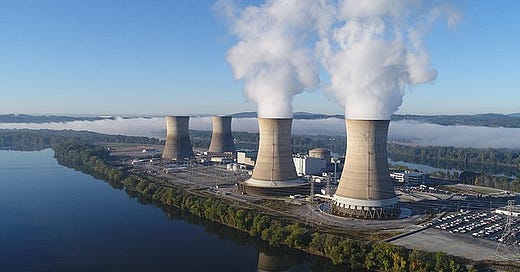I was supposed to be using paid time off today, but this morning brought news too big to sit out: Microsoft is helping fund the restart of Three Mile Island.
You may know the two-reactor power station in Londonderry, Pennsylvania, for the infamous partial meltdown of its Unit 2 in 1979, triggering the worst civilian nuclear accident in U.S. history. No one died, and repeated studies have failed to detect any related uptick in cancer cases from the radiation released during the accident. So Unit 1 carried on for decades until 2019, when – in a climate tragedy – competition from cheap natural gas put the maintenance costs to relicense the facility out of reach and it shut down.
But that was five years ago, before electricity demand started surging for the first time in decades, thanks to a boom in artificial intelligence, the transition to electric cars and heating, and new investments in hydrogen fuel made through electrolysis.
Now every big tech giant is looking for sources of clean and – more importantly – stable and plentiful electricity to supply its growing fleet of data centers.
For years, Silicon Valley behemoths supposedly cleaned up the carbon pollution from their data centers by funding construction of renewable energy plants. The server farms would harvest electricity all day long from grids largely powered by gas and coal, but the solar panels and wind turbines companies like Alphabet and Meta helped fund and locate elsewhere were meant to offset the fossil fuel usage.
That may have been enough to satisfy some environmentalists and ESG investors when electricity demand was flat. But the industry’s growing appetite for power has injected a dose of energy realism into the discussion now, and the intermittent renewables – while cheap and effective for many things – aren’t even close to enough.
Earlier this year, Amazon spent $650 million on a nuclear-powered data center in Pennsylvania. But Microsoft’s 20-year deal – worth $16 billion – sets a new standard for how these tech giants can help spur the long-awaited nuclear renaissance.
Is that enough? Of course not. And there’s likely to be trouble ahead for the cities and ratepayers who are now losing their nuclear plants to big corporate buyers.
You can read more on this here on HuffPost.
Far bigger economic news this week only makes the conditions better for new, expensive infrastructure: the Fed’s rate cut.
In an 11-to-1 vote, the Federal Reserve’s board of governors on Wednesday slashed the key federal interest rate by half a percentage point – twice as big a reduction as Wall Street initially predicted.
It was great news for your 401k, with the S&P 500 smashing yet another record yesterday. But it’s probably even more welcome news for clean-energy developers, who struggled in the face of higher rates.
Since investors have long seen fossil fuel projects as risky given the need to decarbonize, oil and gas companies were already paying 5% or more to borrow money. That wasn’t the case for solar and wind developers until the Fed started ratcheting up rates two years ago to reign in pandemic-induced inflation. For projects like new reactors or carbon capture facilities that may cost even more upfront and take longer to build, thus racking up even more interest on loans, the higher rates were a major setback. Just ask the troubled reactor developer NuScale.
You can read more on that story here on HuffPost.
For more on the interest rates, Lebanon’s electricity crisis, Brazil’s X ban, and… Pokémon, you can listen to my latest appearance on the BBC World Service’s “Business Matters” last night.
Thank you as ever for your attention, I hope you felt these stories earned it. If not, maybe this song will. It’s called “Kids Go Down” by Chinese American Bear, an indie duo from Seattle. It’s got the makings of a TikTok hit.
Signing off and wishing you all a good Shabbos and a nice weekend from sunny Bay Ridge, Brooklyn, where the Democrat running for state Assembly opposes zoning reform but wants to slash Verrazzano tolls for Brooklynites.




